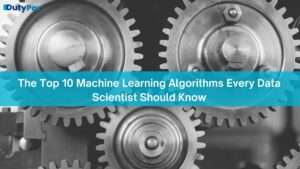 As the field of data science continues to evolve, it’s becoming increasingly important for data scientists to have a solid understanding of the most commonly used machine learning algorithms. These algorithms are the backbone of many modern data-driven applications and are used to analyse data, make predictions, and identify patterns.
As the field of data science continues to evolve, it’s becoming increasingly important for data scientists to have a solid understanding of the most commonly used machine learning algorithms. These algorithms are the backbone of many modern data-driven applications and are used to analyse data, make predictions, and identify patterns.
In this article, we’ll discuss the top 10 machine learning algorithms that every data scientist should know.
Linear Regression algorithms
• Linear regression is a fundamental machine learning algorithm used to predict numerical values based on a set of input features.
• It’s widely used in various fields such as finance, healthcare, and marketing.
• It’s a supervised learning algorithm that aims to find the best linear relationship between the input features and the output variable.
Logistic Regression algorithms
• Logistic regression is a type of classification algorithm used to predict binary outcomes.
• It’s widely used in fields such as healthcare, finance, and marketing.
• It’s a supervised learning algorithm that aims to find the best relationship between the input features and the binary output variable.
Decision Trees algorithms
• Decision trees are a popular machine learning algorithm used for both classification and regression problems.
• They are easy to understand and interpret, making them an ideal choice for decision-making problems.
• Decision trees work by recursively partitioning the input features based on their importance to the output variable.
Random Forest algorithms
• Random forest is an ensemble learning algorithm that combines multiple decision trees to make a more accurate prediction.
• It’s widely used in fields such as finance, healthcare, and marketing.
• Random forest works by creating multiple decision trees on different subsets of the input data and then combining their predictions to make a final prediction.
Support Vector Machines (SVMs)
• Support vector machines are a popular machine learning algorithm used for classification and regression problems.
• They work by finding the best boundary or hyperplane that separates the input data into different classes.
• SVMs are widely used in various fields such as finance, healthcare, and marketing.
K-Nearest Neighbors (KNN)
• K-nearest neighbors is a simple yet powerful machine learning algorithm used for classification and regression problems.
• It works by finding the k-nearest neighbors to a given data point based on the input features and then making a prediction based on the class or value of those neighbors.
• KNN is widely used in various fields such as finance, healthcare, and marketing.
Naive Bayes
• Naive Bayes is a probabilistic machine learning algorithm used for classification problems.
• It’s based on Bayes’ theorem and works by calculating the probability of a given data point belonging to a certain class based on the input features.
• Naive Bayes is widely used in fields such as natural language processing and spam filtering.
K-Means Clustering
• K-means clustering is a popular unsupervised learning algorithm used for clustering problems.
• It works by partitioning the input data into k clusters based on their similarity to each other.
• K-means clustering is widely used in various fields such as customer segmentation and anomaly detection.
Principal Component Analysis (PCA)
• Principal component analysis is a popular unsupervised learning algorithm used for dimensionality reduction.
• It works by finding the most important features or components of the input data and reducing the dimensionality of the data while retaining the most important information.
• PCA is widely used in various fields such as image and signal processing.
Gradient Boosting
• Gradient boosting is an ensemble learning algorithm that combines multiple weak learners to make a more accurate prediction.
• It works by iteratively adding decision trees to the model and adjusting the weights of the input data to improve the accuracy of the model.
• Gradient boosting is widely used in various fields such as finance, healthcare, and marketing.
Conclusion
Understanding the top 10 machine learning algorithms is essential for any data scientist. These algorithms are the backbone of many data-driven applications and are used to analyse data, make predictions, and identify patterns.
By having a solid understanding of these algorithms, data scientists can better analyse and interpret data, make more accurate predictions, and develop better models.
It’s important to note that these algorithms are just the tip of the iceberg when it comes to machine learning. There are many more algorithms and techniques that data scientists should be familiar with, depending on their specific application or field of study. However, by mastering these top 10 algorithms, data scientists will have a strong foundation to build upon and can continue to explore and learn new techniques.
In summary, every data scientist should be familiar with linear regression, logistic regression, decision trees, random forest, support vector machines, k-nearest neighbors, naive Bayes, k-means clustering, principal component analysis, and gradient boosting.
These algorithms cover a wide range of applications and techniques, and understanding them is essential for any data scientist looking to succeed in the field of machine learning.


Comments are closed.